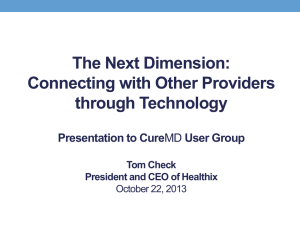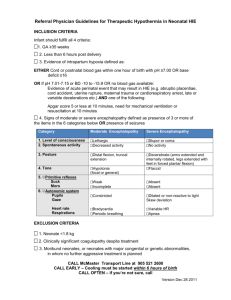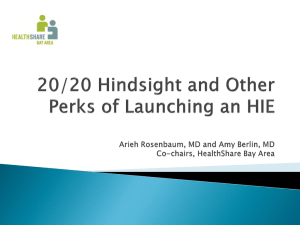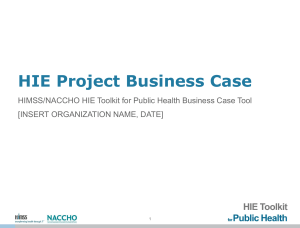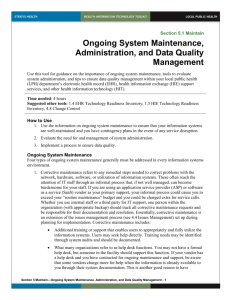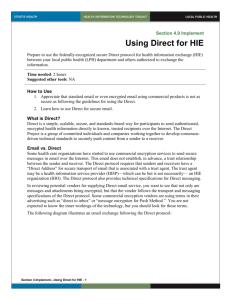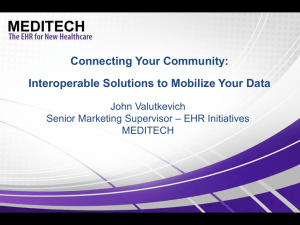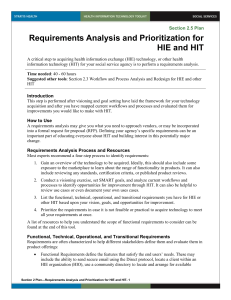Preview
advertisement
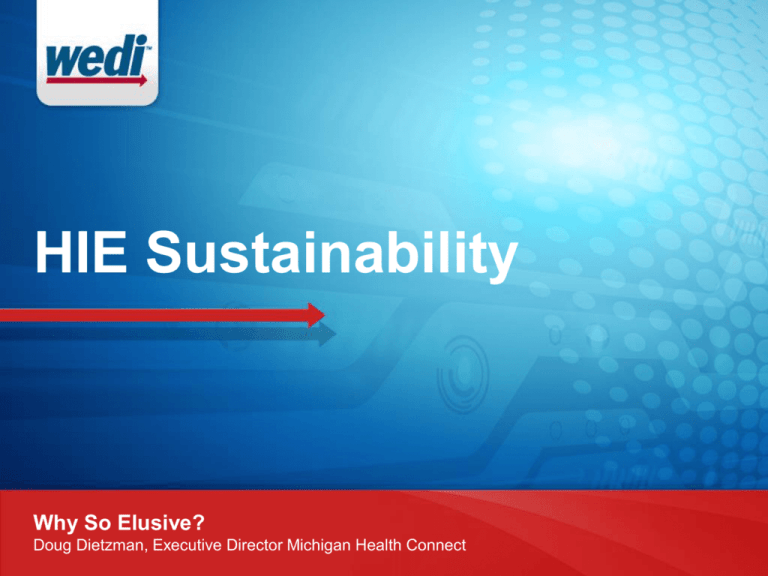
HIE Sustainability Why So Elusive? Doug Dietzman, Executive Director Michigan Health Connect Discussion Topics • What is HIE? • Michigan Health Connect Overview • MHC’s Sustainability Guiding Principles • Broader Thoughts on Sustainability • Q&A 2 What is HIE? • HIE is a personal story for each of us • HIE is not fundamentally about technology What is HIE? • Confusion abounds - HIE is not HIE is not HIE – – – – “Enterprise” HIE “Vendor” HIE “Government” HIE “Community” HIE • Each has different factors driving business model, trust, motivations, and what sustainability means • Sustainability in this webinar will be from Community HIE model context 4 Michigan Health Connect To improve health outcomes for Michigan residents by making relevant, secure data available anytime, anywhere in support of healthcare stakeholders state-wide. • 87 total hospital facilities • 2,105 office locations • 17,000+ providers • 24 other member orgs: Provider organizations, FQHCs, Health plans, Home health, Community mental health, Local public health, Employer Clinics, Diagnostic centers • 4 other HIE connections 5 Today’s Live Solutions • • • • • • • • • • • Results Delivery Admission & Discharge Notifications Lab Orders Radiology Orders Care Transitions/Referrals (Physical & Behavioral Health) Virtual Integrated Patient Record (VIPR) Medication History Community PACS Imaging MCIR Immunization Registry Submission MDSS Reportable Lab Registry Submission Direct HISP (*@mhc.medicity.net) MHC Model & Characteristics • Privately funded & sustainable • True community RHIO – collaboration amongst competitors • Focused on bottom-up incremental value-add services and solutions • Subscription-based “pay-as-you-grow” business model – no cost to physician offices • Members retain control over their data and can participate at their own pace with the solutions that make the most sense for their organization MHC Guiding Principles • There is no need, or requirement, for MHC to “do it all” • Complement and collaborate with, don’t duplicate, existing community services and solutions • Connect all healthcare stakeholders across the continuum – large and small, public and private • Keep providers and other users in their native systems if at all possible • ‘Can be done’ focus rather why things ‘can’t be done’ • Become “Indispensable” and “Invisible” Sustainability Principles • Build the business the old-fashioned way • Core operations not dependent on grant funding Longevity of grant dollars Dictate focus for organization Delay focus on independent sustainability • Ongoing cost structures, including vendor contracts, need to grow as business grows • Member point responsibility on local deployment priorities and activities 9 Sustainability Principles (cont.) • The value of a network is the size of the network – must eliminate financial barrier for community providers • Business model must accommodate and scale from the very large organizations to the very small • Member organizations should only pay for the solutions and services they need, want and use tied to specific value • A single business model will not work for all stakeholder groups – solutions, services, and financial model must be developed uniquely for each group 10 MHC Business Model • Core Participation Fee Hospitals: Licensed beds Health Plans: Per member per month Public Health: Population in counties Etc. • Solution Fees Results/ADT/Immunization Delivery Lab Ordering Radiology Ordering Virtual Integrated Patient Record (VIPR) Admission/Discharge Notifications Etc. 11 Sustainability Example • Results Distribution – Core issue for most hospitals – Key need for community providers with EMRs – Value Proposition: • “you are investing in many point to point interfaces” • “don’t have interest, skills, technology, or vendor knowledge to build and maintain interfaces into community provider offices” • “instead, invest fewer dollars to build one interface to MHC and let MHC take responsibility for connecting with provider offices” – Once data is fluid, how else can value be created from it? 12 Retailer a Retailer a Retailer? • Consider 3 retail stores: Walmart, Brookstone, and Nordstrom • All are “retailers” yet each have a different strategic focus Walmart…low cost Brookstone…product variety Nordstrom…customer service • All must meet basic cost, product and service requirements, but each has selected one of the three to excel in • All have similar business functions at high level, but the way each is carried out is totally in line with its chosen business model • Is there really just one HIE business model we’re all chasing? 13 Summary • There is no single magic bullet to HIE sustainability because HIEs are not the same • Building an HIE business is like building any other business • Get to independent sustainability asap – don’t take grant or other 3rd party dollars unless they are firmly in line with the business strategy • Create a vision for your specific geography then go after it intentionally and incrementally 14 QUESTIONS 15 Doug Dietzman Executive Director, Michigan Health Connect ddietzman@michiganhealthconnect.org 616-588-4700 www.michiganhealthconnect.org 16

